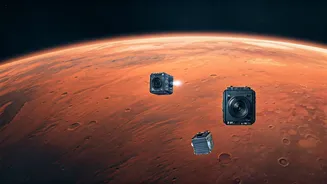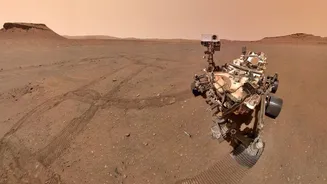Initial Misconceptions Unveiled
Previously, the recurring slope lineae (RSL) on Mars, appearing as dark streaks, had been widely interpreted as evidence of flowing liquid water, particularly
during warmer Martian seasons. This inference was fueled by observations of the streaks' seasonal behavior, seeming to appear and fade with temperature fluctuations. The assumption held significant weight within the scientific community, directly impacting the direction of Mars exploration missions and the prioritization of potential landing sites. The presence of water, being a fundamental requirement for life as we know it, fueled optimism about the possibility of extant or past life on the planet. This early perspective significantly influenced both the research focus and public perception of Mars' potential for habitability and the broader search for extraterrestrial life within our solar system.
AI's Transformative Analysis
The recent investigations, supported by artificial intelligence, introduced a new dimension to this long-standing debate. The advanced analytical capabilities of AI allowed researchers to re-examine existing data from various Martian missions, including high-resolution images and spectral analyses. The AI's ability to swiftly process massive datasets and identify subtle patterns led to novel insights. Researchers focused on the geological and environmental factors on Mars, particularly considering the fine dust prevalent on the surface. The AI models simulated multiple scenarios, considering dust movement, surface properties, and seasonal variations. By analyzing these complex simulations, scientists were able to formulate an alternate theory for the streaks' appearance, challenging the water-based hypothesis.
Dust Avalanches: The Answer?
The AI-assisted analysis indicated that the streaks might be the consequence of dust avalanches. These avalanches occur when dry dust, mobilized by factors such as temperature changes or pressure shifts, slides down slopes, creating dark, streak-like features. This model explains the seasonal behavior without relying on the presence of liquid water. The AI model pointed out that the Martian dust, known for its fine-grained and cohesive properties, could become unstable under specific conditions, promoting such occurrences. The model further showed a strong correlation between the locations of the streaks and areas with certain geological features that might be conducive to dust avalanches, reinforcing the dust avalanche hypothesis. The discovery represents a significant departure from previous interpretations, changing the way scientists perceive the planet's surface dynamics.
Implications for Future Missions
This revelation has significant ramifications for future exploration initiatives and landing site selections on Mars. The earlier assumption about water sources played a vital role in choosing regions for missions seeking potential evidence of extant or past life. However, if the streaks are not related to water, then the focus shifts to different factors, such as the composition of the Martian soil and dust, the geological aspects that influence dust avalanches, and the possible role of other chemical compounds. Researchers will likely reconsider their exploration strategies, placing increased emphasis on analyzing the planet's subsurface environments and other areas where liquid water might be present, such as ice deposits or potential underground aquifers. The updated perspective on the Martian environment requires a more thorough evaluation of the planet's suitability for life and demands more sophisticated research tools and methods to comprehend the complexities of the Red Planet.
Rethinking Martian Habitability
The discovery calls for a reevaluation of the planet's potential habitability. While the absence of widespread liquid water on the surface, as suggested by the study, diminishes the chances of finding easily accessible water, it doesn't rule out the possibility of life. Scientists will need to refocus their search on environments where water may exist in different forms, such as subsurface ice or potentially in briny solutions deep below the surface. They should also explore other mechanisms that might sustain life. Furthermore, understanding the dust avalanche dynamics can offer insights into the surface's capacity for harboring organic molecules and the possibility of past or present microbial life. The new research underscores the necessity of continuous investigation and the value of adopting evolving scientific hypotheses as space exploration continues its quest to understand Mars and the likelihood of life beyond Earth.














